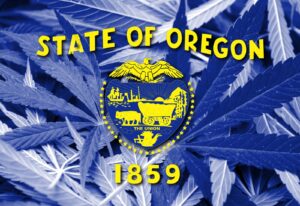
On December 22, the Oregon Liquor Control Commission (OLCC) adopted a large packet of rules amendments that incorporate the many cannabis bills signed by Oregon Governor Kate Brown, as well as “technical amendments [made] in response to market realities.” These changes, effective December 28, 2017, include:
- implementation of mandatory seed-to-sale tracking for medical cannabis;
- a new regulatory regime for hemp and hemp products that allows hemp products into Oregon’s recreational cannabis supply chain;
- new rules governing Marijuana Promotional Events;
- new canopy limits for growing immature plants outside of the standard canopy areas;
- an exception to the retailers-must-be-1,000-ft-from-a-school rule if there is a physical or geographical barrier between the retail site and the school that prevents children from traveling to the retailer, such as a river;
- new certifications for recreational wholesalers that can now trim cannabis, and can offer mobile for-hire trimming services;
- some minor changes to transportation rules;
- a small change to the definition of “financial interest” that will have a big impact on what investors must be pre-approved by the OLCC;
- a new prohibition on sales through walk-up windows to complement the existing prohibition on drive-thru sales (Makes you wonder who came up with the work-around that led to this rule change); and
- micro-tier producers can now do some processing of cannabis concentrates.
Marijuana Promotional Events
Marijuana Promotional Events, governed by OAR 845-025-1335. This new administrative rule allows recreational licensees to display their products at trade shows, which is something many of our clients have been eager to do for a while.
Under the new rules, trade shows or similar events will be organized by a single licensee or “Event Organizer”, that will be the primary contact with the OLCC. The Event Organizer must submit an application to the OLCC at least 28 days before the event that will include the names and signatures of any participating licensees, the amount and type of cannabis items that will be on display, and a control plan that explains how the participating licensees will prevent violations.
Assuming the OLCC approves an application, the participating licensees may bring and display marijuana and marijuana products from their inventory (sorry, no hemp). All of the marijuana must be returned to the licensee’s premises at the end of the event. Thus, these trade shows are not an opportunity to sell or otherwise distribute any cannabis products. Even samples are prohibited.
The ban on samples will probably dissuade some members of the public from attending, but that rule is no different than the ban on samples from licensed dispensaries generally. On the licensee side, trade shows may prove invaluable for smaller industry players hoping to distinguish themselves in a very competitive market. The other possibility, of course, is that licensees may find the regulations too strict, and decline to participate.
Lenders Must Be Disclosed
We dig into a small but important change to the definition of “financial interest” that could have widespread effects on the Oregon cannabis industry: under the new rules, all lenders are pulled into the “financial interest” definition, and must be disclosed.
Historically, the definition of financial interest has not included lenders at commercially reasonable rates. But the new amendments add the following to the definition of “financial interest”: “lending money, real property or personal property to an applicant or licensee for use in the business that constitutes a substantial portion of the business cost.” OAR 845-1015(23)(a)(B). The new rules make no attempt to define a “substantial portion of the business cost,” which means that someday, someone may test that definition in administrative litigation.
As a bit of background, the OLCC has always been interested in knowing the identity of each individual or entity that has a financial interest in a cannabis license. In the initial application process, applicants must disclose anyone with a financial interest in the company (in many cases, this includes spouses). The application can be denied if the interest holder has an issue that would justify denial if that person was an applicant, such as a (serious) criminal history. A licensee also has several notice requirements relating to anyone with a financial interest in the company:
- A licensee must notify the OLCC within 10 days if a financial interest holder has a change in contact information.
- A licensee must notify the OLCC within 24 hours if a financial interest holder is arrested or convicted of a misdemeanor or felony. Failing to do this can result in license revocation.
- A licensee must submit a form to the OLCC and receive prior approval before making any change in who has a financial interest in the company. The OLCC has the right to reject the proposed change.
Prior to the recent change, the definition of “financial interest” was already fairly broad: “an interest in [licensee] such that the performance of the [licensee] causes, or is capable of causing, an individual, or a legal entity with which the individual is affiliated, to benefit or suffer financially.” This would of course include royalty agreements, commissions, or lease agreements where a landlord is entitled to a percentage of revenue. The rules also clarify that this definition includes “out-of-the-ordinary” employee compensation, borrowing money at a “commercially unreasonable rate”, giving something of value to a licensee for use in the business, and being the spouse of an owner of the licensee. Anyone in these categories must be disclosed to the OLCC.
This small change is going to have big effects. Due to a lack of institutional lending, most financing in this industry comes from hard money lenders or venture capitalist groups. Previously, the OLCC didn’t care about private financing so long as the loans were commercially reasonable. Now, virtually every lender must be disclosed to the OLCC for pre-approval, which will require background checks and possible fingerprinting. This will slow down investment in an already cash-poor industry and may have a chilling effect on potential wealthy investors who may opt to invest in an industry without such invasive requirements.
Canopy Size Changes
We discussed the packet of rules amendments recently adopted by the Oregon Liquor Control Commission (“OLCC”) to implement the many cannabis bills passed by Oregon last year. Now, we want to talk about some important changes to canopy sizes.
Before discussing the specific changes, it is important to note that these rule amendments were adopted in an uncertain time in Oregon’s recreational market. As we have noted before, prices for outdoor flowers appear to be falling quickly and many producers have contacted our office about the possibility of pushing the OLCC to limit producer licenses or enact a moratorium on new licenses. (Note: As of January 8, there were 896 active producer licensees in Oregon, with about 1,000 more in the queue). The reality is that the OLCC does not have statutory authority to either limit licenses or enact a moratorium. Only the legislature can make this kind of change, and we think that it is unlikely that it will be considered in the upcoming short session. Unlimited licenses will be the law of the land for the foreseeable future.
While the OLCC may not be able to limit licenses, it does have the authority to set canopy sizes, i.e. the size of the allowed cultivation area for each producer tier. Obviously, while existing producers may favor a moratorium on new licenses, they certainly don’t want a reduction in canopy sizes. From this point of view, the new rules are a bit of a mixed bag.
Previously, the OLCC’s rules allowed for an unlimited number of immature plants on each grow site. The canopy areas designated for each producer were for mature plants only. For example, a micro-tier I producer could have up to 625 square feet of mature plants and an unlimited number of immature plants. Many outdoor grow operations maximize yield by ensuring that they have a constant supply of near-mature plants ready to replant in their canopy area after each harvest. The new rules will put a damper on this strategy.
Specifically, the recent amendments create a new distinction between mature and immature canopies. Mature canopy sizes are identical to the previous rule, but can now contain both mature and immature plants. The new immature canopies are significantly smaller than the correlated mature canopy for outdoor producers. Here is the new breakdown:
Mature Canopies – Indoor (same as previous rule)
- Micro tier I: Up to 625 square feet.
- Micro tier II: 626 to 1,250 square feet.
- Tier I: 1,251 to 5,000 square feet.
- Tier II: 5,001 to 10,000 square feet.
Mature Canopies – Outdoor (same as previous rule)
- Micro tier I: Up to 2,500 square feet.
- Micro tier II: 2,501 to 5000 square feet.
- Tier 1: 5,001 to 20,000 square feet.
- Tier II: 20,001 to 40,000 square feet.
Immature Canopies – Indoor or Outdoor
- 625 square feet for Micro tier I producers.
- 1,250 square feet for Micro tier II producers.
- 5,000 square feet for Tier I producers.
- 10,000 square feet for Tier II producers.
Remember that outdoor producers could previously have as many immature plants on a site as they could fit. This change drastically reduces that number. However, producers should keep in mind that “if immature plants are grown on racks or shelving within the immature canopy, only the footprint of the area containing the immature plants will be used to calculate the immature canopy.” OAR 845-025-2040. So grow vertically!
It is also worth noting that the rules amendments implement a further restriction on all production canopies. All producers that renew after April 1, 2018, will be limited to 20 total canopy areas, and each canopy area must be separated by a physical boundary (a wall), or at least eight feet of open space.
While it remains to be seen whether this amendment will have any effect on Oregon’s supply glut, it seems certain that the legislature won’t be considering the issue anytime soon.
Industrial Hemp Regulation
Industrial hemp regulation has been going through a series of rapid shifts since 2016 when the Oregon legislature adopted a two-tier system that allowed for the registration of industrial hemp growers (producers) and handlers (processors). At the time, only hemp handlers could sell industrial hemp products. This changed when Governor Kate Brown signed into law SB 1015, which allows industrial hemp to enter into the recreational cannabis supply line.
Just before the new year, the OLCC adopted amendments to its administrative rules on cannabis that implemented SB 1015, providing much-needed guidance on the new hemp regime. First and foremost, the term “industrial hemp” refers to any cannabis plants with a THC concentration below 0.3 percent, mirroring the definition under federal law. Hemp growers and handlers can apply to the OLCC for an industrial hemp certificate ($500 per year, plus a $250 application fee) to transfer hemp to recreational processors, and handlers can also receive a certificate to transfer their hemp concentrates and hemp extracts to recreational processors.
None of this answers the question that we receive most often from industrial hemp producers: “Can I sell my industrial hemp products outside of Oregon?” It goes without saying that OLCC retailers must sell locally, so any hemp products transferred into the recreational supply chain can only be sold in Oregon. Hemp outside of the recreational chain is regulated by the Oregon Department of Agriculture (ODA). The ODA’s rules are surprisingly wide open when it comes to the sale of industrial hemp products. Under OAR 603-048-0100, a hemp handler can sell hemp products “to any person.” The ODA’s rules make no reference to whether that sale must occur in Oregon.
While interstate sales of hemp products may be legal in Oregon in certain circumstances, federal law on the issue is anything but clear. The DEA has taken the position that any concentrate or extract derived from the flower, leaves, or resin of any plant of the cannabis family, regardless of relative THC concentration, is a prohibited Schedule I drug. In contrast, the mature stalks of such a plant and fiber from such stalks, as well as oils or cake derived from hemp seeds or stalks are not included in the federal definition of marijuana and are not subject to federal prohibition. There is currently a lawsuit pending before the Ninth Circuit Court of Appeals that challenges the DEA’s position, and we can hope that the court will provide a bit of guidance in this area. For now, we still advise our clients to keep their products in Oregon.
Note: Portions of this post were originally published in the Portland Mercury and are republished here with permission.


























